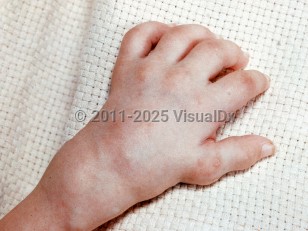The presentation of FD ranges greatly, from severe manifestations resulting in fetal death from hydrops fetalis to attenuated forms that are not diagnosed until adulthood.
The classic presentation in infancy is composed of the cardinal triad of subcutaneous nodules, hoarseness, and progressive tender joint deformities.
Subcutaneous nodules are lipogranulomas composed of ceramide-filled macrophages. They are usually present over bony prominences and joints but have been described in the oral cavity, nostrils, and ears. The nodules may be hyperesthetic. Keloid formation may also be a feature.
Granuloma formation in the larynx causes progressive hoarseness in these patients, who commonly will also have difficulty feeding and poor weight gain. Infants may develop a weak cry, which can progress to dysphonia or aphonia. Enlargement of nodules in the upper airway may cause airway obstruction requiring tracheostomy.
Joint involvement is most often of interphalangeal joints, wrists, elbows, knees, and ankles and is commonly among the first presenting findings. Patients can develop joint contractures that are progressive and can severely limit mobility.
Central nervous system (CNS) involvement is variable but often correlates to cutaneous phenotype and results in progressive psychomotor retardation as well as seizures.
Other reported clinical manifestations include ophthalmic, gastrointestinal, hematologic, pulmonary, hepatic, and orthopedic symptoms.
FD is categorized into 7 subtypes:
- Type 1, classical variant – Characterized by the cardinal triad of subcutaneous nodules, hoarseness, and progressive tender joint deformities. Symptoms typically present in infancy, and patients have a life expectancy of 2-3 years.
- Type 2, intermediate variant – An attenuated disease variant phenotypically similar to type 1. Patients have a longer life expectancy due to decreased neurologic involvement.
- Type 3, mild variant – An attenuated disease variant phenotypically similar to type 1, but with more severe joint involvement. Patients have a longer life expectancy due to decreased neurologic involvement.
- Type 4, neonatal-visceral variant – A severe disease variant characterized by organomegaly and visceral histiocytosis. Patients have the cardinal triad symptoms, but they are less severe than type 1.
- Type 5, neurologic progressive variant – A severe disease variant characterized by progressive neurologic deterioration. Patients have the cardinal triad symptoms, but they are less severe than type 1.
- Type 6, combined Farber and Sandhoff disease variant – A combination of FD and Sandhoff disease, an inherited neurodegenerative disorder.
- Type 7, prosaposin deficiency variant – Patients have a concomitant mutation of prosaposin, which results in a deficiency of glucocerebrosidase, galactocerebrosidase, and ceramidase.



